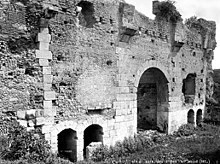Calama (Numidia)
 Calama: Roman theatre | |
| Location | Algeria |
|---|---|
| Region | Guelma Province |
| Coordinates | 36°28′02″N 7°25′48″E / 36.467313°N 7.430052°E |
Calama was a colonia in the Roman province of Numidia situated where Guelma in Algeria now stands.[1]
G. Mokhtar places it just within the Roman province of
History
Calama was founded by the
Whether Calama is identical with the town of Suthul which the Roman general Aulus Postumius Albinus unsuccessfully tried to take in 110 BC,[10] (cf. Battle of Suthul) is disputed, with some denying[11] and others cautiously affirming.[12][13]
In the 1st century AD, Calama, then part of the
Calama became a Christian
- Donatus (not to be confused with handed over the sacred scriptures during the Decian persecution
- Megalius gave episcopal ordination to Saint Augustinein 395 and died in 397
- Donatistbishops
Possidius wrote the first biography of Augustine,
No longer a residential
The invading Vandals captured and partially destroyed Calama and defeated Count
After the conquest of Numidia by the Byzantine Empire, Solomon (a general of Justinian I) built a fortress there between 539 and 554. Calama's population was fully Christian in the 6th and 7th century.
With the spread of Islam, Byzantine rule of Calama ended (some Christians survived until the 9th century) and slowly Calama disappeared around the 11th century (see Guelma).
Archeological remains
- Theatre.[22] It is difficult to reconstruct the plan and general appearance of the Roman theatre. The only other important monument discovered are the public baths. The theatre was built in the first or second year of the 3rd century AD through the generosity of a certain Annia Aelia Restituta, who spent 400,000 sesterces on it. It was restored, indeed virtually rebuilt, from 1902 to 1918, after having served as a quarry. It is on a slope and measures 58.05 m in width. It was built with a rubble core revetted with ashlar. The tiers of seats had virtually all disappeared; they must have numbered 10 in the lower zone and 12 in the second. The orchestra was paved in marble. Behind the stage, which was flanked by two rectangular chambers, a portico with columns formed a facade.

- Baths. The public Roman bathswere built of rubble and revetted with ashlar and brick. These "thermae" may date as early as the 2nd century AD. Only one large rectangular chamber (22 x 14 m), undoubtedly the tepidarium, can be described; it gave onto other rooms and onto the exterior by 11 passages. These baths were included within the Byzantine fortress, no doubt built on an earlier enclosure and defended by 13 towers. It measured 278 x 219 m.
- Forum. The existence of a forum is attested by a single inscription. There are also remains of arcades, a small shrine of Neptune, cisterns and, outside the town, a Christian church. In 1953 a hoard of 7,499 coins was discovered; virtually all of them came from the mint at Rome; the most recent dated to the beginning of AD 257.[citation needed] Presumably the hoard was buried because of local disturbances. Most of the ancient objects recovered at Calama and from the region are preserved in the Guelma Museum.
- Citadel and walls. Among its ruins are also a Byzantine citadel and walls built by the Byzantine patricius Solomon during the Byzantine reoccupation.[12][23]
36°28′2.33″N 7°25′48.19″E / 36.4673139°N 7.4300528°E
References
Citations
- ^ "africa agostiniana". www.cassiciaco.it (in Italian). Retrieved 2018-02-01.
- ^ ISBN 978-0-85255092-2, pp. 264–265
- ^ "J.B. Bury, History of the Later Roman Empire, chapter XVII, §3". Archived from the original on 2014-08-26. Retrieved 2014-08-23.
- ^ "Columbia University Libraries: A new classical dictionary of Greek and Roman biography mythology and geography". www.columbia.edu. Retrieved 2018-02-01.
- ^ "Roma Victrix: Mauretania – Numidia – Africa – Cyrenaica et Creta – Aegyptus". Archived from the original on 2014-08-26. Retrieved 2014-08-23.
- ^ Hoover, Jesse. "Map of Donatist North Africa".
{{cite journal}}: Cite journal requires|journal=(help) - ^ "Siti archeologici africani: Calama". www.cassiciaco.it (in Italian). Retrieved 2018-02-01.
- ^ Huss (1985), p. 25.
- JSTOR 41857007.
- ^ Sallust Bellum Iuguthinum, 37
- ^ (Bamberg), Huß, Werner. "Suthul".
{{cite journal}}: Cite journal requires|journal=(help)CS1 maint: multiple names: authors list (link) - ^ a b c d Sophrone Pétridès, "Calama" in Catholic Encyclopedia (New York 1908)
- ^ The United Service Journal. H. Colburn. 1839.
- ^ Calama thermae (in French)
- ^ Pius Bonifacius Gams, Series episcoporum Ecclesiae Catholicae, Leipzig 1931, p. 464
- ^ Stefano Antonio Morcelli, Africa christiana, Volume I, Brescia 1816, pp. 115–116
- ^ H. Jaubert, Anciens évêchés et ruines chrétiennes de la Numidie et de la Sitifienne, in Recueil des Notices et Mémoires de la Société archéologique de Constantine, vol. 46, 1913, pp. 19-24
- ^ a b "St. Possidius". Midwest Augustinians. Retrieved 2018-02-01.
- ^ Calama, Possidius of. "Possidius, Life of St. Augustine (1919) pp.39-145". www.tertullian.org. Retrieved 2018-02-01.
- ^ Chapter 12 of the Life
- ISBN 978-88-209-9070-1), p. 855
- ^ Roman Theatre (in French)
- ^ "Guelma" in Encyclopædia Britannica
Bibliography
- Huss, Werner (1985), Geschichte der Karthager, Munich: C.H. Beck, ISBN 9783406306549. (in German)
- Smith Reid, James. The Municipalities of the Roman Empire University of Michigan Press. Chicago, 1913
External links
- Images of Calama (Guelma) theatre and baths in Manar al-Athar digital heritage photo archive


